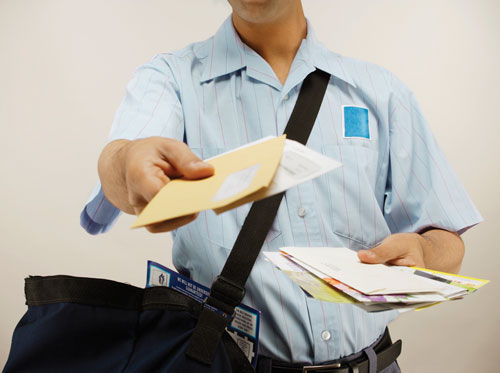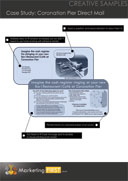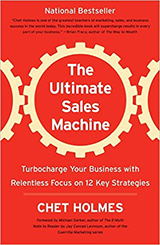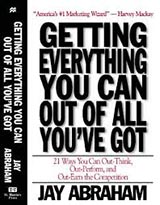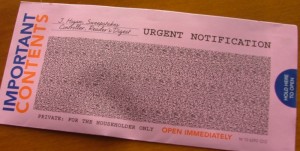
If you are human and you have a letterbox (or even a pile of bricks at the start of your driveway that someone could stick a letter into), then chances are, you have received one of these Readers Digest Sweepstakes letters.
If you haven’t, then I am amazed.
So, what can we learn from Readers Digest Sweepstakes letters that you can put to work on your business?
Lesson #1: There are ways to measure the effectiveness of your advertising, don’t give up because it seems too hard
This is the 96th time they have run the sweepstakes. Would they run it year after year if it didn’t work? No.
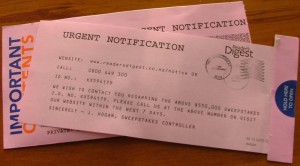 Do other companies run ads that don’t work again and again? Well actually, yes they do.
Do other companies run ads that don’t work again and again? Well actually, yes they do.
Many companies don’t bother to measure the response from their advertising. Most of them don’t bother because it seems to hard.
What a waste of money! There are so many ways to measure the response for advertising, and doing so answers the essential question “is this ad providing us with a return on investment, or is it a waste of money?”
Anyway, you can bet your bottom dollar that Readers Digest a measuring the ROI from this little flyer. It’s easy to do because they have pinned down the recipient to a very narrow, very precise, call to action. You have to call a specific 0800 number and quote a code number. Which brings us to lesson 2:
Lesson 2: Specify the action you want the audience to take, isolate that action so its easier to measure, and incrementally improve
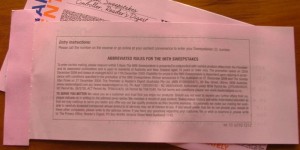 This is genius because they could even test 2 different versions of the flyer at the same time by providing one 0800 number for one part of the country, and another 0800 for another part of the country. The flyer that generates the most calls becomes the new default, and next time they can test another change.
This is genius because they could even test 2 different versions of the flyer at the same time by providing one 0800 number for one part of the country, and another 0800 for another part of the country. The flyer that generates the most calls becomes the new default, and next time they can test another change.
(By the way, this is called “A-B testing” and I use it when I manage my clients Google Adwords campaigns so our ads become better and better over time.)
Another cool way to measure results:
Another way you could measure the impact of your ad is to use a mini-website instead of an 0800 number as the call to action, so you can see exactly how many hits you get via different promotions delivered to audiences on different dates.
Lesson #3: Is your advertisement different enough? Can you cram in some more cheesy gimmicks? (or is there another way?)
This letter uses a whole lot of techniques to make it stand out from the rest of the junk mail:
- The envelope looks crazy different
- It’s pink
- There is a mystery about its contents because it has a security scribble on the front so I can’t hold it up to the light to see what’s inside
- It makes up for the fact it’s not addressed to me with promises like “private: for the householder only” (that’s me!), “Open Immediately”, “Important Contents”, Urgent Notification (they wouldn’t say it if they didn’t mean it!)
- An official looking serial number is stamped on the bottom
What efforts have you made to make your ad stand out?
Actually, rather than cheesy gimmicks like this, I favour writing headlines that capture the audiences imagination, or tap into a deep psychological need, or create an itch that begs to be scratched. I’ve found that an effective headline can weed out the time wasters, lock into the true prospects, and give you a chance to deliver more message.
Lesson #4: You can’t sell your product or service cold, so sell only the next step in the sales process
This is where this letter really shines. They don’t try and sell the Readers Digest Magazine. They don’t even mention it. All they are selling is your chance to win a jackpot. That doesn’t seem like selling at all! It’s like they are doing you a favour for giving you the chance to claim a prize that has already been reserved for you!
Ok, ok, in this case, they have thrashed this concept to death, so many of us know that all that awaits us once we get through this hurdle is another hurdle and another hurdle until we are so exhausted that when they ask us to buy a magazine subscription we agree just out of pure exhaustion.
Anyway, focus on the lesson: This letter has one purpose: to get people to call the 0800 number and graduate through to the next step in the sales process. Any information that does not achieve this objective does not belong in this letter.
Are you guilty of trying to cram information into your ads? Sure you are. We all are. Are you trying to tell them about your company, about your products, about what you can do for them, and trying to convince them to make a decision on the spot?
Yes, you probably are.
Can you boil down what you have to offer into one simple step that your prospects can take?
Sure you can.
Give it a shot.
Share your thoughts about this article below.
